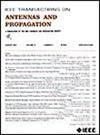一种用于220-GHz频段的高效率高增益大元阵列
IF 4.6
1区 计算机科学
Q1 ENGINEERING, ELECTRICAL & ELECTRONIC
引用次数: 0
摘要
与小型辐射元件相比,大型辐射元件可以减少相同阵列孔径内功率分配器的级数和损耗,显著提高阵列的辐射效率。然而,当它们组成阵列时,它面临着光栅瓣的挑战。本文研究了矩形点阵大元阵列旁瓣电平的影响因素。结果表明,副瓣与元件间距无关,但与孔径效率和阵列规模密切相关。元素的AE和数组维数建议至少为82% and 4, respectively. The lens is selected as the large element’s architecture because its optimized feed and phase-shifting surface make it relatively easy to achieve a higher field uniformity, that is, a higher AE. Methods for extracting the 1-D aperture efficiencies of a 2-D region are proposed in this article to validate the derived SLL rules in full-wave simulations, and a simplified form is employed for the rapid optimization of architectural parameters. Finally, a $4\times 4$ scale high AE lens array is designed with an element size of $6\lambda _{0} \times 10\lambda _{0}$ . The reached directivity at 220 GHz is 39.7 dBi, with AE almost above 70% within the $170\sim 260$ -GHz band. For the convenience of measurement, a prototype with a 16-way PD is fabricated. The measured peak realized gain is 37 dBi, with a peak total efficiency of 42% and a 3-dB gain bandwidth of 20.7%.本文章由计算机程序翻译,如有差异,请以英文原文为准。
An Efficiency-Enhanced High-Gain Large-Element Array for 220-GHz Band Applications
Compared to small radiating elements, large elements can reduce the stages and the losses of power dividers (PDs) within the same array aperture, significantly enhancing the array’s radiation efficiency. However, it faces the grating lobe challenge when they are formed into an array. This article investigates the factors that affect the rectangular lattice large-element array’s sidelobe levels (SLLs). Results show that the sidelobes are independent of element spacing but closely related to aperture efficiency (AE) and array scale. The element’s AE and number in the arraying dimension are suggested to be at least 82% and 4, respectively. The lens is selected as the large element’s architecture because its optimized feed and phase-shifting surface make it relatively easy to achieve a higher field uniformity, that is, a higher AE. Methods for extracting the 1-D aperture efficiencies of a 2-D region are proposed in this article to validate the derived SLL rules in full-wave simulations, and a simplified form is employed for the rapid optimization of architectural parameters. Finally, a $4\times 4$ scale high AE lens array is designed with an element size of $6\lambda _{0} \times 10\lambda _{0}$ . The reached directivity at 220 GHz is 39.7 dBi, with AE almost above 70% within the $170\sim 260$ -GHz band. For the convenience of measurement, a prototype with a 16-way PD is fabricated. The measured peak realized gain is 37 dBi, with a peak total efficiency of 42% and a 3-dB gain bandwidth of 20.7%.
求助全文
通过发布文献求助,成功后即可免费获取论文全文。
去求助
来源期刊
CiteScore
10.40
自引率
28.10%
发文量
968
审稿时长
4.7 months
期刊介绍:
IEEE Transactions on Antennas and Propagation includes theoretical and experimental advances in antennas, including design and development, and in the propagation of electromagnetic waves, including scattering, diffraction, and interaction with continuous media; and applications pertaining to antennas and propagation, such as remote sensing, applied optics, and millimeter and submillimeter wave techniques

 求助内容:
求助内容: 应助结果提醒方式:
应助结果提醒方式:


